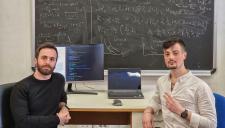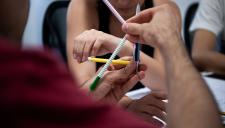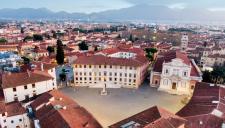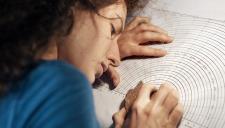An experiment to explore the aftermath of cosmic dawn, when stars and galaxies first lit up the universe, has received nearly $10 million in funding from the National Science Foundation to expand its detector array in South Africa.
The HERA collaboration expects eventually to expand to 330 radio dishes in the core array, each pointed straight up to measure radiation originally emitted some 13 billion years ago. Twenty outrigger dishes (not shown) are also planned, bringing the array up to 350 dishes total.
The experiment, an international collaboration called the Hydrogen Epoch of Reionization Array, or HERA, currently has 19 14-meter (42-foot) radio dishes aimed at the southern sky near Carnarvon, South Africa, and will soon up that to 37. The $9.5 million in new funding will allow the array to expand to 240 radio dishes by 2018.
Led by UC Berkeley, HERA will explore the billion-year period after hydrogen gas collapsed into the first stars, perhaps 100 million years after the Big Bang, through the ignition of stars and galaxies throughout the universe. These first brilliant objects flooded the universe with ultraviolet light that split or ionized all the hydrogen atoms between galaxies into protons and electrons to create the universe we see today.
“The first galaxies lit up and started ionizing bubbles of gas around them, and soon these bubbles started percolating and intersecting and making bigger and bigger bubbles,“ said Aaron Parsons, a UC Berkeley associate professor of astronomy and principal investigator for HERA. “Eventually, they all intersected and you got this über bubble, leaving the universe as we observe it today: Between galaxies the gas is essentially all ionized.“
A 13.8-billion-year cosmic timeline indicates the era shortly after the Big Bang observed by the Planck satellite, the era of the first stars and galaxies observed by HERA and the era of galaxy evolution to be observed by NASA’s future James Webb Space Telescope. HERA image
That’s the theory, anyway. HERA hopes for the first time to observe this key cosmic milestone and then map the evolution of reionization to about 1 billion years after the Big Bang.
“We have leaned a ton about the cosmology of our universe from studies of the cosmic microwave background, but those experiments are observing just the thin shell of light that was emitted from a bunch of protons and electrons that finally combined into neutral hydrogen 380,000 years after the Big Bang,“ he said. “We know from these experiments that the universe started out neutral, and we know that it ended ionized, and we are trying to map out how it transitioned between those two.“
The HERA array, which could eventually expand to 350 telescopes, consists of radio dishes staring fixedly upwards, measuring radiation originally emitted at a wavelength of 21 centimeters – the hyperfine transition in the hydrogen atom – that has been red-shifted by a factor of 10 or more since it was emitted some 13 billion years ago. The researchers hope to detect the boundaries between bubbles of ionized hydrogen – invisible to HERA – and the surrounding neutral or atomic hydrogen.
By tuning the receiver to different wavelengths, they can map the bubble boundaries at different distances or redshifts to visualize the evolution of the bubbles over time.
UC Berkeley’s partners in HERA are the University of Washington, UCLA, Arizona State University, the National Radio Astronomical Observatory, the University of Pennsylvania, the Massachusetts Institute of Technology, Brown University, the University of Cambridge in the UK, the Square Kilometer Array in South Africa and the Scuola Normale Superiore in Pisa, Italy.
“In mapping out the distant Universe, this experiment hopes to fulfill the dreams of all Cosmologists. We are thus very excited about the project,” notes Andrea Ferrara, professor of Cosmology at Scuola Normale. “We here at SNS are at the cutting-edge of being able to interpret data from HERA, clarifying what the observations tell us about the first galaxies,” adds his colleague, Andrei Mesinger, who sits on the HERA executive board and is co-financing the project with a European Research Council grant”.











